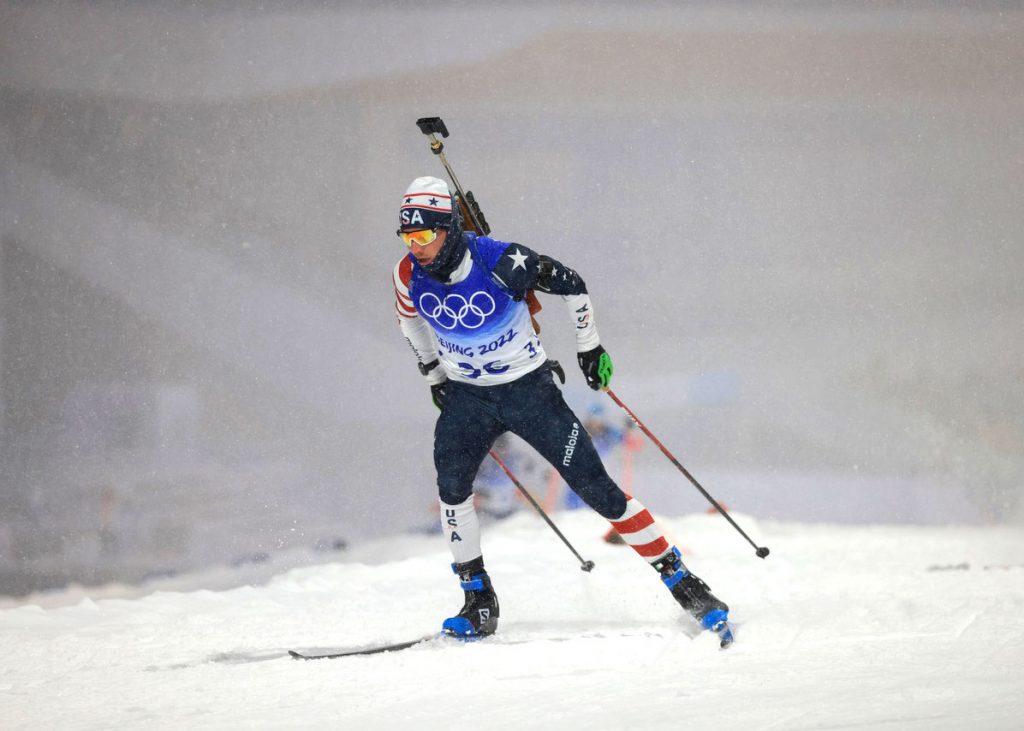As much as the athletes, the story at the National Biathlon Center in Zhangjiakou on Saturday night, Feb. 13, was the weather. Blustery weather—bone-chilling temps and wind gusts that blew a light snowfall sideways and challenged competitors in the men’s 12.5km pursuit. But the conditions didn’t seem to faze Quentin Fillon Maillet of France, who won his fourth medal of the Beijing Olympics by finishing in 39 minutes, 7.5 seconds and shooting clean. Silver medalist Tarjei Boe of Norway crossed the finish 28.6 seconds later (with one missed target); it was the second individual medal overall for this four-time Olympian, the other being a bronze in the 10km sprint.
Eduard Latypov of the Russian Olympic Committee followed just 7 seconds behind Boe for bronze, also with one target missed. Meanwhile Boe’s younger brother, three-time Olympian and three-time overall World Cup winner Johannes Thingnes, had a disappointing race, missing seven targets and finishing fifth, after winning the 10km sprint and sharing that podium with Tarjei. “You had wind, tired legs, tired minds and hearts beating—it was not easy,” he said of the pursuit, which he started in first position because of his sprint win.
The 60 best finishers in the women’s and men’s sprints qualified for the pursuit, with starting order based on their sprint results.
With this win, Fillon Maillet’s count now equals the record number of biathlon medals won by a male at one Olympics. “I never expected to have four medals in four races,” he said. “My goal [is] to have one in relay and one in individual, but right now I have four medals and that’s incredible.” Indeed, he’s been on a roll, also winning the 20km individual and taking two silvers, one in the 10km sprint, the other as part of the mixed relay team. Fillon Maillet underwent some unusual mental prep before the Games—he spent two days with an elite unit of the French police force, intentionally placed in staged yet stressful situations so he could learn to better regulate his response to pressure.
Just before the men’s race, World Cup leader Marte Olsbu Roeiseland of Norway resoundingly won her third gold medal of these Games in women’s 10km pursuit. She finished in 34 minutes, 46.9 seconds—more than a minute and half before the next woman to cross the line—and missed only one target in her shooting. It’s the largest margin of victory in any women’s biathlon race at any Olympics. Roeiseland, who became the first woman to win four biathlon medals at one Olympics, also placed first in the women’s 7.5km sprint and was part of the winning team in the mixed relay. She earned a bronze medal in the 15km individual.
Sweden’s Elvira Oeberg took silver in what she called “probably one of the hardest pursuits I’ve ever raced” while Roeiseland’s teammate Tiril Eckhoff, who won bronze concurred, saying, “It was a tough race, and I had to work my ass off to get a medal.”
Four American women qualified for the pursuit: team veteran Susan Dunklee (who has said this is her last Olympics), Clare Egan, Deedra Irwin and Joanne Reid. “Making the pursuit and having all four of us be competitive in this race, it’s been an historic Olympics for all of us,” Irwin said. Of the U.S. women’s team’s development over the past couple of years she added, “It’s been a long time coming, but we’re sure happy it’s here now.” Reid led the American squad with a 29th place finish, followed by Egan (38th), Dunklee (40th) amd Irwin (47th). Dunklee celebrated her 36th birthday on race day; her teammates had planned a small surprise party for her afterward.
Weather conditions during the women’s race were slightly less challenging than during the men’s—the wind wasn’t blowing as hard—but both events shared another factor: new, cold snow that softened the track, hindering speed. “It felt like everything was going in slow motion out there,” said Oeberg, who took silver in the 7.5km sprint, too.
“On a course like this, with so many long, gradual climbs, you just got no free glide at all,” said American Sean Doherty, a three-time Olympian who trains with the Vermont Army National Guard. “It’s kind of like skiing in sand.” Doherty finished in 43rd place in the men’s pursuit. The frosty temps and unpredictable gusts also wreaked havoc with Doherty’s shooting. “I took six clicks on in prone, which is half the distance of the prone target just because of the wind,” he related. “And then my bolt was like totally frozen. I’m actually lucky I didn’t have to take the spare rifle.”
Additionally, as with all the races during these Games, there’s the altitude; at almost 5,600 feet, the course has one of the highest elevations of any Olympic biathlon venue. (The maximum altitude at which competitions can take place is 1,800 meters, or 5,900 feet). Many teams spent months, if not years, training to compete in the thinner air. By the end of both races, many athletes were fighting to get the feeling back into frozen fingers, toes and cheeks. And then there was the issue faced by U.S. biathlete Jake Brown, from Edina, Minnesota, and competing in his first Olympics; he placed 40th. “I actually was throwing up on the downhill on the last lap, which I’ve never done before,” he said. “And I was kind of afraid that it was going to freeze on me but luckily that didn’t happen.” We’ll call that a win of a different kind.





